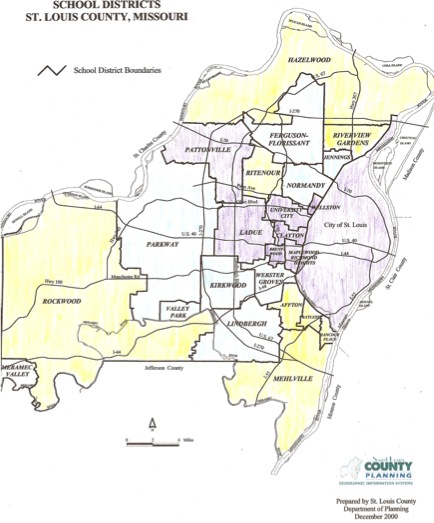Teachers should teach, not be police
Visit NBCNews.com for breaking news, world news, and news about the economy
The Sandy Hook massacre inside an elementary school has shocked us all. While we want everyone to be safe, we expect our youngest to be so inside their own school.
My children attend Clayton School District, one of the wealthier districts in St. Louis County. Like many local districts, it already has police officers at the high school and middle school. On Monday when I went to pick up my youngest, I saw a different police officer at the elementary school. I was a bit taken aback but assumed he was there to help parents feel more secure in the first few days after the Connecticut shooting. I am hopeful that the district does not spend money to keep police officers or even armed security at the elementary schools long-term as the expense would not be justified.
Other school districts such as Kirkwood and Florissant are considering police officers at elementary schools in their school safety reviews. I believe, however, that time and calm parents will help them spend limited resources wisely.
I do agree that schools should review safety procedures as they have after each school shooting and periodically otherwise. Safety experts learn from each experience. For example, whoever turned on the intercom at Sandy Hook, whether intentionally or not, alerted the teachers to the severity of the problem. These types of details are important to safety plans.
St. Louis County Police Chief Tim Fitch said that each officer costs a district about $50,000 for a nine month contract. (Really a 10-month contract) In order to afford that, the district would need to lay off a teacher at each elementary school. That is not a trade-off I am willing to make.
As an alternative to paying for police officers at the schools, some politicians such as Texas governor, Rick Perry, have advocated arming teachers as a way to make schools safer. On Sunday, Chief Fitch brought the gun control debate squarely to the St. Louis school districts.

The St. Louis Post-Dispatch followed up with a front-page story discussing Fitch's suggestion and other security possibilities. The local districts did not react with enthusiasm.
Fred Crawford, chief of security for the Parkway School District, said he would favor more police in schools over gun training for school officers.
The districts are right to hesitate. Teachers with guns in the classroom, even in a locked drawer, would bring a whole new set of problems to schools. That gun is more likely to be found and used against the teacher or other students, the teacher is not going to be as experienced as an active police officer, that gun is unlikely to be useful against a prepared killer like Adam Lanza with a bulletproof vest on, the teacher would be spending time helping students to safety, police might mistake teacher for intruder etc. I would not send my kids to school with a teacher carrying a gun or with a gun in a locked drawer in the classroom. If the gun is locked up in the office, I would still feel uncomfortable. Who would have access? Have the parents been notified who has access? Their training? The date and continuation of their training?
In addition, districts hire teachers to teach, not to act as security.
"I'm a former teacher and my daughter teaches currently. I want our teachers to be trained so that we can address the problems of literacy, so that we can improve our education system. Let the public safety people handle these other issues." --Rep. John Larson (D) Conn. on NOW with Alex Dec. 17, 2012
Districts should re-evaluate their safety plans and assess whether to add more security, depending on the local needs, not as an emotional reaction to a horrific situation. They should not, however, ask teachers to become that security force.
Districts Need Higher Math Expectations for All
Cross-posted to Clayton Richmond Heights Patch
School districts throughout Missouri are reevaluating their math programs because the state is planning on adopting the new Common Core standards. While some people may balk at the idea of nationalized standards, politicians need to put their petty power disputes aside and look at what is best for kids. Massachusetts said it would not join the coalition unless the standards were at least as rigorous as its own, driving the standards up rather than the more typical downward spiral we tend to expect. While the Missouri MAP tests are challenging, the standards were poorly written. Adopting the Common Core standards is a positive step.
Clayton School District's math curriculum committee has made some substantial recommendations in its cyclical review of the math program. Other districts will be looking at their math programs whether they are up for review or not because of the upcoming changes in standards.
Clayton recommended changes:
•eliminating the integrated math sequence at the high school
•requiring the majority of 8th graders to take a full algebra course in 8th grade instead of the “algebra light” course currently taught
•recommending new textbooks for the high school and middle school (elementary will be reviewed this coming year)
•beefing up content mastery and fluency at the elementary
•requiring Algebra I level knowledge for all elementary teachers, Algebra II level knowledge for middle school math teachers
While the board seemed pleased with the amount of work put into the 621-page document, the members were not completely satisfied. They wanted more.
“Will this document guide us to ensure our teachers and curriculum teach a variety of ways so all of our children can excel?" she [Susan Bradley-Buse] asked the committee. “I don’t see that in here.” (Travis Pringle, “Math Curriculum Update Draws Questions on Textbooks, Teaching Styles”Clayton-RH Patch 29 April 2011)
I want to see math educators broaden their view. Instead of focusing on test scores and teacher recommendations to select a few students into the honors sequence, they need to emphasize looking at practices that can help as many students as possible excel at a high level.
Districts often provide support structures for struggling and exceptional students, but what about making those available for a wider base? For example, Clayton currently offers extra support courses for students in regular math classes so that they can be successful. This can help many students avoid taking less-intensive courses but gives them the extra help needed. I think this is a wonderful concept that should be more broadly applied. Possibilities could include a summer class to help middle school students move from regular math to honors, tutoring sessions taught by college and high school students, support groups for math anxiety, etc.
Finland consistently ranks at or near the top on the international test PISA. All students take the same course together with struggling student provided extra help.
A tactic used in virtually every lesson is the provision of an additional teacher who helps those who struggle in a particular subject. But the pupils are all kept in the same classroom, regardless of their ability in that particular subject. (Tom Bridge, “Why do Finland’s Schools Get the Best Results?” BBC 7 Apr 2010)
U.S. students are not the same as those in Finland, but teachers here can learn from their strategies for helping all students.
Moving algebra to the 8th grade for the majority of students is a good first step, which I would like to see replicated across the metropolitan area, but I think we need to go further. Students should be encouraged, not discouraged to challenge themselves even if it takes some extra work.
I’m not advocating eliminating honors courses but emphasizing to students that practice and hard work is more important than innate ability in achieving at a high level in math. If districts start ability grouping at a young age, they have a responsibility to counter that unspoken message by providing creative and productive extra support all students could use to excel in math.
Canyon between high school and college expectations

(Photo by OliBac)
UMSL, Mizzou and the other UM-System campuses require students to have a 24 composite on the ACT or equivalent SAT scores to be accepted as freshmen. (They can be accepted with lower scores with high grades and class rank. See rubric.)
Unfortunately, our high schools are not graduating students at that level. The average ACT composite score in Missouri is 21.6 It's much lower at some of our metro school districts.
Clayton School District provides a good picture since they have all (or almost all at 92.48%) seniors take the ACT. In 2011, they had a composite score of 25.8, well above the state average and above the state university cut-off. However, the UM campus cut-off of 24 is a minimum, not a mean, so even many Clayton students wouldn't test high enough to be accepted.
Ferguson-Florissant had 68.75% of its seniors take the ACT in 2011 with a mean composite score of only 18.4. In order to be accepted to Mizzou or UMSL with that ACT score, a student also has to be in the top 14% of their class and have a 3.5 gpa in their core classes (no padding!).
Riverview Gardens seniors don't have much of a chance. In 2011, 58.74% of seniors took the ACT with a dismal composite score of 16.1. If their ACT score is below a 17, no matter what their class rank or grades in their core classes, they will not be admitted to Mizzou or UMSL. Being accepted to a 4-year state university will be challenging for most students from Riverview Gardens, nevermind the costs. There is a reason this district is currently unaccredited.
Every child should graduate from high school with the option of going to college, whether they choose to or not. The difference in expectations between high school graduation and college entrance is a canyon rather than a ravine for too many of our kids.
Let them eat...zucchini?
| The Daily Show With Jon Stewart | Mon - Thurs 11p / 10c | |||
| Little Crop of Horrors | ||||
| ||||
With the attention paid to our nation’s pathetic eating habits and the Obama’s organic garden, now seems to be a good time for the St. Louis area school districts to vastly improve their school lunches. Maplewood Richmond-Heights is in front of the “Race to the Top”, in terms of lunches anyway, as it implements its Healthy Eating with Local Produce grant in conjunction with St. Louis University.
"The kitchen staff has reshaped menus and already ordered their produce from the farmers in the Missouri Farmers' Union," superintendent Henke said. "Some of our high school students will have summer jobs helping process the foods this summer." (Gardening Teaches, Suburban Journals, 2 June 09)
This is in sharp contrast to most of the area school districts. Yes, they may offer some fresh fruit and vegetables at a food bar, a recent and welcome addition, but the overall menu is still weak.
Here’s a typical week’s menu. This one is for elementary schools from one week in May from Kirkwood school district, which uses Chartwells.

Here’s a menu from Chef Ann Cooper’s elementary menu (pdf). A daily menu might be chicken or veggie quesadilla, rice and beans, salad bar, 1% milk, fresh fruit.
Elem_calendar_sept
Like Maplewood, Kirkwood, U City, Ferguson-Florissant, St. Charles and Clayton have farmer’s markets within their borders. Let’s step up to the plate, schools.
Making a difference

Changing state laws is doable but can be intimidating and a bit overwhelming. While the patchwork system of school districts in St. Louis County may have its drawbacks, one positive aspect is the individual districts’ responsiveness to its constituents. The “they” is a bit more personal.

Clayton’s bond issue passed by 2.6 votes. That is a close election! When the community didn’t like the Wydown/Washington University land swap idea, people let the board know. This tight election is an extension of that and will not be forgotten. I am confident that the process will be more open and transparent going forward.
University City also passed its bond issue.
Clayton Group Plans to Protest School Bond Vote
School Bond Issues Pass
Clayton School District Bond Issues Passes: Construction May Start in Fall
Election results including school board members
Longer school year?
Arne Duncan is looking at longer school days or years to help improve our country’s education and to help our students compete in a global economy in which many countries such as India and China go 20 to 30 days more a year. I’m sure students won’t like this idea, I doubt teachers will, and I’m not confident parents will either. However, I think that we should consider a longer school year.
I was at a committee meeting last night at my children’s elementary school in which the principal was telling us about a decision made to change the allocation of minutes. Every addition of time is a trade-off. Adding more minutes to the school day isn’t necessarily the best decision since young children need some time to play, but a longer year would ease the minute turf war and reduce summer retention problems.
The parents at the meeting kept asking about when the teachers were able to meet together district-wide by grade level. Teaching has traditionally been a solitary profession but is increasingly team-oriented as planning is done in groups. To facilitate this districts need to provide time for teachers to meet in various teams. Some districts do better at this than others, but all of them need to do more.
School year length ranges from 190 days for Farmington to 167 for Wheatland in Hickory County and Appleton City in St. Clair County. The St. Louis city and county districts have a narrower range from 174 to 178 with Ritenour as an outlier at 182 (good for it!). (Numbers from DESE)
The length of school day in St. Louis county and city ranged from 6.6 in Kirkwood (with quite a few districts at 6.5) to Jennings at 6.0. Jennings has a shorter day and one of the shorter years, but other districts mixed the two. For example, Clayton has one of the longer years but shorter days to allow for after school teacher meetings. Some of the districts such as University City and Bayless had a longer day at 6.5 hours but relatively shorter year at 175 days. Kirkwood, Ladue and Ritenour have students attending the most hours. Jennings and Hazelwood are at the bottom.
The number of hours taught ranged in the state from a high of 1209.5 (Centerville in Reynolds County) to 1014.5 (Calhoun in Henry County).
I predict that the we don’t have a significant change in the next couple of years but a quickening of the incremental pace we’ve been having in the increase of time as pressures mount on districts to improve. The state will need to come in and establish minimums for the rural areas that don’t face the same competition.
Put that curriculum on the website!

Rockwood: detailed information on curriculum by content area, info on curriculum development, easy-to-use website
Mehlville: pdf of each grade and high school
MRH: pdf of each school level (elementary, middle, high) and content area, assessment report, easy-to-use website
Clayton: info on curriculum development including names of curriculum coordinators but not information on content level or grade level objectives
Ladue: info limited to elementary math under the district curriculum section
Ferguson-Florissant: no information on district site that I could find via browsing or by search, no info in at least two elementary schools (Airport Elementary, Bermuda Elementary)
SLPS: no information that I could find via browsing, no search available; no info in at least three elementary schools (Adams, Ashland and Cote Brilliante)
Since curriculum drives education, I applaud Rockwood and MRH for having comprehensive, easy-to-use curriculum sections on their websites. Clayton and Ladue have some catching up to do. Ferguson-Florissant and the SLPS are embarrassingly lacking in this area. While I didn’t look at every district’s website, I encourage educators to think about what they include and emphasize on their websites and the message that sends to their parents and broader community.
District spending seems a bit random
A commenter to skoolboy’s post on the Chicago protest wondered if wealthier districts did a better job educating students eligible for free or reduced lunch. So I ran some St. Louis numbers. Nope.
There is no correlation between per pupil spending in a district and the percent of free or reduced lunch students who test proficient or advanced on the math MAP test. (-.24) There isn’t even a correlation between per pupil spending and the percentage of total students who test proficient or advanced on the math MAP test (-.04)
After looking at the numbers, however, I was surprised at the districts’ spending levels. Clayton having the highest spending is no surprise to anyone, but the number two district is Wellston, the district that has the lowest test scores in the county and that has lost its accreditation.
Does per pupil spending reflect a community’s wealth though? Not as much as we would expect. In fact, not at all. The correlation between per pupil spending and median household income is -.15 (This differs from skoolboy’s findings on Illinois and could from the state of Missouri, but I focused on the St. Louis metro area. I also didn’t use the exact same method he did.)
My next attempt to find a commonality was to draw a map. Bingo. I colored in the top third per pupil spending purple, mid third medium blue and bottom third yellow.

Since the city and middle corridor obviously spend more irrespective of community wealth, I hypothesize that the older buildings cost more to maintain. Obviously, teacher salaries could play a factor here too, but those are numbers to run another day.
I’m not arguing that since there’s no correlation, we should reduce funding for all the districts. However, we also can’t equate funding with equality as so many other factors come into play.
MAP scores highlight U.S. inequality
I am intrigued by the newly released Mo. MAP scores in a similar way to my fascination with political polling, complete with a need to understand the caveats and to dig deeper.
Fareed Zakaria, in The Post-American World, explains the U.S. math score mediocrity.
❝But even if the U.S. scores in math and science fall well below leaders like Singapore and Hong Kong, the aggregate scores hide deep regional, racial, and socioeconomic variation. [...] The difference between average science scores in poor and wealthy school districts within the United States, for instance, is four to five times greater than the difference between the U.S. and Singaporean national averages. In other words, America is a large and diverse country with a real inequality problem.❞
This inquality is highlighted in the St. Louis County MAP scores. The 10th grade math scores ranged from 81.4 percent of a school scoring proficient or advanced at Clayton to 0 at Wellston.
OK, that is pretty extreme. The top five scoring districts averaged 71.6 prof/adv.; while the bottom five districts (excluding Wellston) averaged 15.6. I excluded Wellston because it has had its accreditation stripped and students may go elsewhere. In fact several go to Clayton.
The elementary math numbers aren’t any better. I chose 5th grade because I felt that gave students several years to get used to testing. The top five districts averaged 75.02 prof/adv; whereas, the bottom five averaged 18.76.
What do teachers make anyway?

Source: DESE
I assumed that Clayton would be the top-paying district in the county, and I was correct. The average is high because the district prioritizes experience and advanced eduction. The average number of years teaching is 15.6; while Webster Groves, the next highest, is 14.7—almost a year less.
Clayton, Brentwood and Kirkwood all have over 80 percent of teachers with at least a master's degree. They are also the highest paying districts. This is no coincidence as I found a .76 correlation between average salary and percent with a master's. This is much higher than the still statistically significant .40 correlation between average salary and average number of years teaching.
At a future date I will compare the percent with a master's to quality of schools because in looking at it, that seems to be a pretty good indicator, with Ladue as a weird outlier. (What's up with Ladue only having 50 percent of its teachers with a master's? They're not young (14.1). This deserves further research.)
Greening St. Louis Schools
I have previously challenged districts with building initiatives like Rockwood to include green elements. Parkway is having public meetings where residents can voice their opinions. I'm sure other districts are also considering renovation projects.
Missouri is a bit behind with no LEED certified schools although one is expected to open in Kansas City next year. In St. Louis County, most schools are renovating, not constructing new buildings, which makes the LEED certification trickier. Ohio is requiring all new schools and major renovations to be LEED Silver certified and is helping with funding.
Julia Feder, a green schools advocate for the U.S. Green Building Council St. Louis Chapter, spoke last night (Tues. Feb. 12) to the Clayton school district about the advantages of building green and the "triple bottom line."
Good for environment
nuff said
Good for economics
While building green costs 3-5% more, the payback time is 5-7 years. Obviously, schools last longer than that, so taxpayers benefit. The average green school saves $100,000 per year in operating costs.
❝Analysis of the costs and benefits of 30 green schools and use of conservative and prudent financial assumptions provides a clear and compelling case that greening schools today is extremely cost-effective, and represents a fiscally far better design choice. Building green schools is more fiscally prudent and lower risk than continuing to build unhealthy, inefficient schools.❞ (Greening America's Schools: Costs and Benefits, Gregory Kats, Capital E Report, pdf)
Good for health and wellness
An AIA (American Institute for Architects) report gives some promising data: 38.5 percent reduction in asthma because of improved air quality and 1.41 fewer teacher work days missed. (eSchool News) Improving kids' health because of better building design and implementation is a moral obligation.
Illinois has passed the Green Cleaning for Schools Act, which will help all schools take steps toward making schools a healthier environment. Will Missouri step up?
Learning
A Heschong Mahone Group study showed that daylighting, contrary to previous assumptions, doesn't decrease learning. Instead, students showed a 20-26 percent faster learning rate. I remember the middle school I attended with its miniscule windows. Sigh.
Studies have linked a decrease in ADHD behaviors to time spent in the outdoors. Outdoor classrooms are another component to green schools.
USGBC-STL is giving a presentation "Greening Your School and District 101: What do you need to know to take the first steps?" at Crossroads Preparatory School April 3 8-10 a.m.